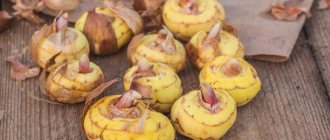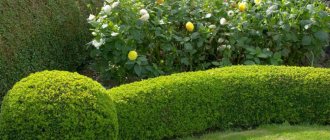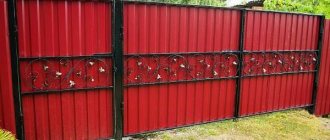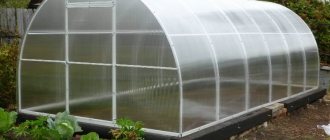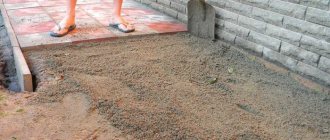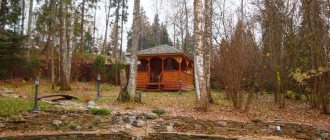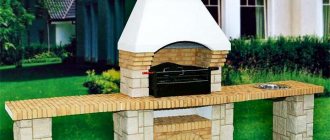Before grabbing a shovel and developing a new bed, let’s look at the definition of what a mixborder is - this is an obligatory element of European landscape design and a relatively new type of complex flower garden of continuous flowering. If you choose the right plants and properly care for them, beautiful mixborders remain so throughout the year. You can improve the art of creating a mixed border flower garden ad infinitum, but it’s better to start with the simplest and most accessible schemes.
DIY mixborder
Mixborder - DIY flower garden
Almost everyone can learn the art of combining plants. For example, after reading this article, every second reader will be able to create with his own hands (without the help of landscape designers) such a complex element of garden design as a mixborder.
Let us say right away that it is extremely difficult to care for such a flower garden, which is most often decorated with perennial and annual plants, cereals and potted flowers, ornamental shrubs and even small coniferous trees. To provide different types of plants with the most proper care, systematic supervision is necessary:
- timely transplantation;
- cultivation;
- watering;
- pruning;
- fertilization and disease prevention.
And if you are not afraid of the upcoming difficulties, and you dream of using mixborders to make your garden or dacha even more picturesque, then it’s time to familiarize yourself with the most important rules for creating mixborders of continuous flowering.
Useful tips
Mixborders that do not require special care are simple and convenient, but even they can wither without proper attention. In order for the mixborder to maintain an attractive appearance and delight the household, it is necessary:
- Ensure regular watering, taking into account weather conditions. It is better to water the flowerbed in the morning or evening.
- Remove weeds and periodically loosen the soil so that the earth does not form lumps.
- Remove dry leaves, branches and inflorescences in a timely manner.
- Fertilize the bud with compost, both during loosening and during flowering of the mixborder.
- Eliminate pests in a timely manner.
Creating a mixborder - where to start?
A mixed border in a garden differs from a border and a ridge in that the flowers in it are placed in loose, dense groups that smoothly flow into each other. At the same time, any mixborder must contain plants that will create a “winter effect” and set the height and shape of the fragrant island. In landscape design they are called “skeletal” or the main islands of the composition.
Having prepared the soil and dividing the area into three unequal parts, first (in the background of the front mixborder) voluminous plants with leaves of interesting shapes are planted. The next row is reserved for tall flowers with straight stems. Then medium-sized plants without lush foliage are placed. Next, low, ground cover plants are planted, followed by annuals.
This tiered placement is done in order to “disguise” the elongated stems of the flowers in the middle ground.
Tiered mixborder
Schemes and photos
There are 2 types of mixborders:
- The flower garden is visible only from one side - in this case, the plants are planted in rows, and low-growing species should be in the foreground (40 cm high), medium-sized ones in the second (60 cm), and the tallest ones in the background (a meter or more).
- A flower garden with a comprehensive view - the plants are planted so that the tall ones are in the center of the composition, and the rest are planted, selected according to the gradual decrease in their growth.
Let's look at the ready-made schemes:
Before buying seeds or plant seedlings, be sure to make a plan. When designing it, you need to consider:
- composition and type of soil;
- air humidity;
- lighting (sunny or shaded);
- Is the area protected from the wind?
It is also necessary to take into account what kind of root system the plants have, so that creeping rhizomes do not spread over the surrounding area. After all, then other plantings will suffer, and the harmony of the flowerbed will be disrupted.
Important! Plants that are selected for a mixborder should have similar needs in terms of moisture consumption, type of soil and amount of sun exposure.
Here are some more landing rules:
- You cannot plant tall plants near the viewing point that will block the view of the flower garden;
- the continuity of flowering of such plantings can be ensured by planting annual plants that bloom for a long time;
- The background for a flower garden must be green leaves, which, with their lushness during the period between the flowering of different plants, do not allow it to lose its decorative effect (for example, ferns, heucheras and hostas);
- if at a certain moment the flowerbed has not acquired a presentable appearance, then you can get out of the difficulty with the help of flower pots, arranging them for a while.
Choosing a location for a mixborder
Flower beds of free outlines (this is what gardeners also call mixborders) are placed in open sunny areas or (if these are “woody mixborders”) in slightly shaded areas.
Coniferous-heather perennial compositions, composed of a mixture of various plants: heathers, eric, rhododendrons and dwarf varieties of conifers, look especially impressive along a hedge, a small hill, the facade of a house or on the edge of a terrace.
Coniferous-heather perennial compositions
“English mixborder”, the basis of which is garden and wild perennial plants, is most often placed against the background of a lawn, parallel to the paths leading to buildings, along the walls of the house. A mixborder along a fence or fence will emphasize and complete the composition of the landscape design of the site.
Prefabricated compositions or “combined mixborders” are laid out over large areas. The length of such an elongated flower bed is practically unlimited - it can occupy the entire perimeter of the site or only its inner part. In this case, part of the flower garden is in the open sun, part in partial shade and part in the shade.
“Shrub mixborders”—compositions collected from beautifully flowering and decorative deciduous shrubs—look organically next to a country house or a luxury cottage.
And if the “shrub mixborder” is a relatively new element, then the “seasonal” one is a long-proven option for a garden still under construction, where planting perennial plants is irrational.
You can beautifully complement the composition of a shady garden with the help of a decorative foliage flower strip formed from shade-tolerant shrubs and flowers.
Regardless of location, mixborders must be planted in rows. In this case, low members of the plant composition (up to 40 cm) are planted in the foreground, medium (up to 60 cm) and tall (100 cm or more) - in the background.
Color design
The choice of colors is tied to the style of the flowerbed and the overall landscape design. The calm English style is characterized by perennials with green, bluish, and white leaves. Inflorescences can have pinkish-raspberry, blue-violet, and classic white shades.
The middle of the “garden” mixborder will be decorated with rosemary, yellow and red cherry tomatoes, decorative peppers with red and purple flowers. In the foreground you can place bluish-purple basil, salads of different colors, and shade them with the calm greenery of ornamental cabbage. In the background you can plant climbing beans (if necessary, you will have to install supports), decorative corn with green-pink leaves “Motley Ribbon”.
The shape of the mixborder can be the most unusual. Intricate flower beds of irregular shapes, diverging in “streams” in different directions, look impressive. For lovers of geometrically precise shapes, round, triangular, and oval compositions are suitable. An empty area at the turn of the path, in the corner of the fence or next to the porch will be decorated with a corner mixborder of perennials.
Important! There are no restrictions when choosing the shape of a flower bed. The bright colors of the flower garden look advantageous against a monochromatic background - near the wall of the house, next to a fence or tall bush.
Plants for mixborders
The words that came to us from Foggy Albion “mix” (from English mix) and “border” (from English border, border) have become an integral part of gardens in any style. And at the same time, only at first glance it seems that the plants on the mixborder are planted chaotically. Of course this is not true. But many novice amateur gardeners, knowing little about the compatibility of plants and their requirements, plant everyone nearby. As a result, instead of a picturesque strip, something neglected and sloppy appears.
For example, you should not plant fast-growing perennial plants with creeping rhizomes (for example, Louis wormwood) in a mixed border with a very high planting density. Yes, they really suppress the growth of annoying weeds, but they have an extremely negative effect on the growth of some capricious plants, such as lily of the valley and other bulbous plants.
That is, ready-made mixborders, which we most often see in colorful pictures, are both an exciting and incredibly difficult project, the success of which depends entirely on the right choice of plants.
Step-by-step design of mixborders from perennials, conifers and shrubs with your own hands
A mixborder flower garden in a dacha garden will attract attention from early spring until October-November, if the plants are selected so that some, as they bloom, replace others. At the same time, green foliage will play an important role in the design of this kind of flower garden, which, during the flowering period of certain species, will not allow the mixborder to lose its splendor and decorativeness.
Features of the mixborder layout
The term “mixborder” is borrowed from the English language. It means "mixed border" or "mixed border". Even beginners can create a flowerbed of constant flowering from perennial plants. Externally, the flower garden looks like a winding flower bed of chaotically located plants of different heights, reminiscent of a corner of wild nature. In fact, there is no accident in the placement and selection of colors. Even the location chosen for the flower bed matters. There is no point in arranging it where no one can admire the flowering.
Typically, a mixed border is installed near the porch, near a pool or pond, at the front entrance to the house, along the paths. Often mixborders of perennials are planted along the fence, as in the photo below:
What to consider when planning:
- the landing site must carry a semantic load;
- the selection of flowers depends on the season and period of their flowering;
- Flowers with the same light sensitivity and a closed root system going vertically down are recommended:
- multi-tiered compositions are preferable, which will reveal the beauty of each of the perennials;
- When landing, you should take into account the viewing angle so that the most winning combination is in sight.
The harmony of the floral arrangement should not be disturbed by wilted or dried flowers. In the case of perennials, such a danger does not exist. Thanks to decorative greenery, they remain attractive even after they finish flowering.
If, when planning a mixborder of perennials, it is difficult to select a sufficient number of plants, the flower garden can be “diluted” with annual flowers. It is better to place them next to plants that, after flowering, become not very attractive, and select the timing so that annuals replace faded perennials. However, there should not be too many of them so that the flower garden does not need to be redone next year.
Important! Some perennials are not recommended to be planted in large tracts of mixborders. For example, delphiniums need to be cut after the flowering season. If there are too many of them, an unpleasant hole may form. The best option is single specimens scattered throughout the flowerbed.
Mixborder scheme 1 - flower garden of perennials
Mixborder of perennials - diagram
In this example of a mixborder, the bottom row contains:
No. 5 “Cinquefoil shrub”
. Potentilla blooms from July to August. In autumn, the plant is dressed in a mesmerizing golden “dress”. And in winter, its reddish branches stand out noticeably against the white snow.
No. 4 “Coreopsis whorled”
.The low-growing plant blooms profusely and for a long time. From the end of June until the very frost, coreopsis pleases with yellow flowers with different shades: lilac, pink or brown.
No. 3 “Majestic geranium”
. The bush blooms in July for 30-40 days. Geraniums acquire a brick-red or yellow-orange hue in the fall.
No. 2 “Soft cuff”
. This perennial herbaceous plant blooms with small yellow cloud-like flowers from June to July. But gardeners plant mantle in a mixborder of perennials not because of its cute inflorescences, but for its luxurious leaves with a wavy edge.
No. 1 “Geranium Endressa”
. Blooms profusely all summer. In late autumn and winter, it decorates the flower garden with dark green, palmate leaves. The frost-resistant spherical bush is not afraid of temperatures even at – 40C.
The middle row contains the following flowers for mixborders:
No. 5 “Cinquefoil shrub”
(in this mixborder scheme it is located on the right in the bottom row and on the left in the middle row).
No. 6 “Yarrow ptarmika”
. This perennial plant blooms in July and lasts until the end of summer.
No. 7 “Decorative bow”
. Landscape designers often include this amazingly beautiful plant in mixborders of perennials. And that's why. The fact is that decorative onions add a certain charm to any floral combination of a mixborder. Even after blooming on the first day of summer (the main flowering occurs in May-June), dried balls of inflorescences delight the garden until late autumn.
No. 8 “Fennel polygonum”
. The plant with a corolla color ranging from lilac to dark purple reaches a height of 1 m. It blooms from July to August.
No. 9 “Verbena bonarskaya”
. Elegant verbena, strewn with small purple stars, easily fits into any flower garden, even one as difficult to arrange as a mixborder with roses. The persistent plant blooms from June until severe frosts.
No. 10 “Boxwood”
. This slow-growing shrub is not particularly difficult to care for. It is valued not for its small blooms, which are rare but occur in early spring, but for its spectacular evergreen crown.
No. 11 “Decorative wormwood”
. The filigree, lacy leaves of this foliage plant make it unlike any other garden plant. Against its background, an ordinary wildflower seems mysterious.
In the background of the described mixborder scheme the following are planted:
Note that this mixborder is best placed along a fence or wall of a house.
No. 12 "Lofant"
. The versatility of this plant lies in its ability to bloom from July until late autumn. The bush grows quickly and looks incredibly impressive in the background of a mixborder.
No. 13 “Echinacea purpurea”
. A beautiful flower with bright petals has completely unattractive foliage. Therefore, Echinacea is always placed between other plants to create the illusion of a lush flowering shrub.
No. 14 "Khatma"
. The shrub, which sometimes reaches two meters in height, blooms profusely from July until the first frost.
No. 15 "Clematis"
. Velvety delicate flowers of white, pink, blue and red colors delight the eye from early spring to late autumn. Their amazing flowering can only be interrupted by persistent frosts.
The decorative effect of a tiered flower garden can be enhanced if perennial plants are planted in groups, as in the detailed mixborder diagram below:
Tiered mixborder - diagram
It is very important that the group of plants with which you are going to decorate the mixborder have similar needs: requirements for soil acidity and its fertility, moisture supply and light level. So, all the flowers in the diagram presented above grow well in both full sun and sparse shade. They are not too capricious to care for, which means they can be fed and watered in a complex manner.
Basic principles of caring for a mixborder
Since in a mixborder each species is allocated a certain territory, an important step in caring for a flower garden is to control the growth of vegetation. This is especially true for plants that grow quickly or have an aggressive root system that suppresses their neighbors. Their aboveground part is subject to systematic pruning. Of course, if this is a background plant, pruning is carried out in a more moderate manner.
The growth of the root system is controlled by a border tape dug into the soil. Rejuvenation of plantings is also carried out: plants are dug up, their root system is divided into parts, and the strongest sections are planted again in their place.
This should be done every 2-4 years, depending on the development characteristics of each species.
The variety of vegetation used also makes it difficult to care for a mixborder. This is due to the fact that plants react differently to sun, shade, dryness or soil moisture. To simplify the care of a mixed flower garden, it is recommended to select plants with similar requirements for the composition and moisture of the soil, lighting, and feeding requirements.
dizlandshafta
Mixborder design in the garden - all shades of mood
Even the most beautiful flowers that are discordant in color can create chaos in a flower arrangement and completely destroy it. A color scheme, carefully and competently thought out, is important for any flower garden, and especially for a complex mixborder.
A flower garden built on contrasts makes a lasting impression. It seems incredibly bright and sets the rhythm for the entire infield. For example, impressive contrasts are created by combinations of purple and canary yellow, rich green and red, sky blue and orange. At the same time, you should not plant plants of contrasting shades randomly. Visually, the colors will mix and become muddy. The best option is to choose plants with large flowers as accent plants and plant small-flowered specimens of a different color in small spots among them.
The monochrome mixborder (photo of which is presented below) looks elegant and deep. It is relaxing and adds a neat touch to the entire garden. The ideal monochrome in a flower garden is three colors, with smooth transitions from one color scheme to another. To liven things up, plants with white flowers are often included in a monochrome composition.
From perennial and annual plants
Option 1.
Mixborder of fern (Matteuccia struthiopteris) of the onocleaceae family and impatiens walleriana:
Option 2
Perennial herbaceous plant Astilbe Chinese (lat. Astilbe chinensis) and Salvia (Sage) lush New Dimension.
Option 3
Purple petunias and morning glory (Ipomoea batatas), which in the West are known as sweet potato vines, can easily be replaced with regular morning glory.
Mixborder - group planting scheme
Material prepared for the website www.moydomik.net
Design of a monochrome blue-blue flower garden
No. 1 “Small-stamened geranium”
. Flower beds are most often decorated with large bushes of this catchy and very bright plant. And that's why. Geranium can grow without transplanting for more than 10 years. Blooms from mid-June to August.
No. 2 “Anhuza Dropmore”
. A beautiful plant with blue and sky-blue flowers blooms in May and adorns the mixborder until July-August.
No. 3 “Multifolia lupine”
. A completely problem-free plant. It blooms for the first time in May, followed by a second and third wave of flowering.
No. 4 “Delphinium “Blue Bird”
. This charming perennial is easy to grow even for a novice gardener. Large semi-double flowers appear for the first time at the beginning of summer, the second at the end.
No. 5 “Syrian Hibiscus”
. It does not like shade and pleases with lush flowering from June to October only with a sufficient amount of ultraviolet light.
No. 6 “Catnip”
. Lush blue catnip clusters decorate the garden all summer.
No. 7 "Mordovnik"
. The blooming period of blue-blue flowers occurs in June and July. Loves the sun, but is also cold-resistant.
No. 8 “Delphinium “Blue Lace”
. Magnificent flowers raise their inflorescences high (up to 2 m), charming everyone around.
No. 9 “Veronica longleaf”
. Small, blue flowers with white spots appear on the plant in July and decorate the mixborder until the first frost.
No. 10 "Veronica"
. The flower seems fragile and delicate only at first glance. In fact, it easily tolerates sun, drought, and shade. Blooms from May to late summer.
No. 11 "Iris"
. This unusually beautiful flower is simply created for garden accents. Flowering continues for about a month in June-July.
No. 12 "Len"
. Blooming flax looks like a sky blue carpet. New buds of the sky blue plant appear over a period of three months - from June to September.
Creation tips for beginners
Despite the fact that you can find a lot of ready-made diagrams on the Internet and read all the necessary information, creating a mixborder with your own hands is not so easy. Planting such a flower bed requires the gardener not only basic knowledge, but also experience. Therefore, we have prepared basic rules that will be useful at the initial stage:
- Consider the existing conditions. Light level, soil acidity and composition, wind strength, minimum and maximum temperatures.
- Study the proposed plants. Typically, seed packages indicate the flowering period, plant size, and requirements for growing conditions.
- Decide on the appearance. Which style and palette will suit you best?
- Start by choosing skeletal plants. Dense shrubs that maintain their appearance from spring to autumn or all year round. The distances between them will later be filled with small annuals.
- Don't go overboard with the quantity. Many different species in several copies form a mess, it is better to choose a maximum of 3 tall, medium, low plants. This is usually sufficient.
Important! Don’t forget the main thing: a mixborder is a living organism. Therefore, in order for it to remain in good condition, it requires constant care, which consists of watering, weeding, pruning, and removing yellowed sectors.
Mixborder of conifers and shrubs - additional elements
When including additional decorative elements in the design of a mixborder, which itself is incredibly bright and self-sufficient, you need to be especially careful. Lack of a sense of taste and proportion can lead to a beautiful mixborder turning into an absurd exhibition of mushrooms and gnomes.
To prevent this from happening, landscape designers recommend adding large stones to a large mixborder with conifers and shrubs, as if by chance. The cobblestones do not need to be laid out in a straight line. It is better if the boulders randomly peek out from under the plants.
If you plan to design a double-sided wide mixborder at your dacha, then inside it you can create slightly noticeable paths made of large flat stones or tiles.
Mixborder of conifers and shrubs with stones
Mixborder styles
Lugovoy. Reflects the romance of mountain and meadow landscapes. Meadow grasses and various cereal crops are used in their creation.
English. There is a strict style in the design here. Clarity of lines, severity of forms and restraint of colors are the main features of such a flower garden.
Rustic. The variety of bright colors, the splendor of flowering, the assortment of plants consists mainly of local crops.
Vegetable. They create a mixborder design from various vegetable crops, choosing the color of leaves and flowers. It also has a functional meaning, because in the fall gardeners can collect their bonus - a harvest of vegetables.
Mixborder of shrubs - ready-made schemes
Large and dwarf shrubs in a mixborder provide consistency and determine the structure of the flower garden. With proper pruning, shrub plants can grow for years without requiring special attention.
Thus, the most popular shrubs that bloom at different times of the year include: forzatia, rowan, viburnum, serviceberry, rhododendron, camellia, magnolia, hydrangea, barberry, redroot, chaenomeles and others. We are pleased with the beautiful leaves: holly, angustifolia, bay laurel, boxwood, holly, pieris, mahonia and many others.
By adding coniferous trees and several lush, large perennials to the shrubs, we get a mixed mixborder.
Along the fence
The mixborder in the diagram below, the most successful location of which will be along the fence, consists of:
- Derena cornus alba Gouchaulti,
- Derena Sibirika,
- Diablo bladderwort,
- Tui Smagard,
- Spiraea Vangutta or Chubushnik,
- Thuja occidentalis Hoveyi,
- Euonymus Fortune variety Aurea Variegata,
- Sedum prominent,
- Heucheras,
- Hosts,
- Astilbe,
- Siberian iris,
- Peonov,
- Hortensius.
Coniferous mixborder with shrubs and perennials - diagram
No. 1 “Dwarf spruce cushion”
. The decorative nature of the needles and the compact size of this coniferous shrub make it an incredibly popular element in garden landscaping. (1 PC.)
No. 2 “Asters and Tulips”
. By selecting plants from different classes and groups, you can get colorful compositions that bloom from mid-spring until summer. (60 pcs.)
No. 3 “Byzantine Chistets”
. An unpretentious and charming plant with fluffy leaves blooms all summer and often becomes a decoration for mixed plantings. (7 pcs.)
No. 4 “Phlox”
. The perennial flower amazes with its diversity. In this mixborder scheme with shrubs and conifers, it is recommended to use pink or purple phloxes, which do not lose their decorative relevance from spring until autumn. (10 pieces.)
No. 5 “Oak sage”
. Sage spikelets bloom from June to September, reaching a height of 30-70 cm. (8 pcs.)
No. 6 “Prominent sedum”
. The finest hour of a beautiful bush with large, oval bluish-green leaves comes in August and lasts until the first frost. During this period, the plant blooms beautiful pink-lilac flowers. (6 pcs.)
No. 7 “Astilbe”
. The delicate inflorescences of this perennial appear in July and do not lose their charm for a whole month. (10 pieces.)
No. 8 "Peonies"
. In terms of decorative foliage and beauty of flowers, peonies rightfully occupy one of the first places among garden plants for mixborders and other flower beds. Very early groups of bushes with a luxurious aroma begin to bloom in early June, the latest ones - at the end. Peonies retain their bright beauty until autumn. (3 pcs.)
No. 9 "Delphinium"
. When a delphinium blooms like a bright spot in the garden, it instantly becomes the center of the mixborder composition, because... on one thin trunk of this wonderful plant there are 80 large flowers at once. (7 pcs.)
No. 10 “Rhododendron”
. The cushion-shaped crown of this evergreen shrub is decorated with flowers from May to June, and then at the very end of summer. (3 pcs.)
No. 11 “Thuja western Danica”
. The maximum diameter of the crown of this spherical coniferous plant does not exceed 1 meter. (1 PC.)
In the first years, until the plants have gained full strength, the gaps and voids in the coniferous or shrub mixborder must be filled with annual plants - flowers that live only one year.
Rules for combining plants
The correct choice of neighboring species is the key to the success of the design. It is important to select plants according to the following parameters:
- height;
- decorativeness;
- flowering period;
- features of care.
With the right approach, the flowerbed will turn out surprisingly coordinated. The plants will not wither, the plantings will delight you with continuous flowering.
Understanding how to make a mixborder correctly is important for any gardener. The flowerbed option is popular and easy to implement. Such a flower garden will be an ideal solution for different areas.
Do-it-yourself landscaping of the site - interesting ideas and creative options for designing a summer cottage and adjacent area (135 photos)- Do-it-yourself rabatka: 145 photos on how to create a cool shape and choose flowers for a rabatka
DIY rock garden - 115 photos, diagrams, projects and video master class on how to create a beautiful rock garden
The most beautiful annuals for mixborders:
- cold-resistant annual plants
: soporific poppy, Damascus nigella, petunia, borage, pelargonium, Douglas limnanthes, calendula officinalis, begonia, etc.;
- annuals, blooming all summer
: aster, snapdragon, lavatera, marigold, sweet pea, cornflowers, iberis, violet, blue nemophila, dwarf viola, ageratum and others;
- annuals that bloom in late summer
: carnations, dahlias, asters, chrysanthemums, sunflowers, white Iberis and many others.
Selecting the shape and location for the flower garden
A one-way view mixborder can be placed along the fence
Particular attention should be paid to the location of the mixborder. You can place a one-way viewing flowerbed near fences or next to the house. The so-called island flower garden, viewed from all sides, is most often located on the slopes. When choosing a location, you should also pay attention to several of the following recommendations:
- Height of selected plants. If you plan to plant specimens reaching a height of more than 3 m, then you should not place the mixborder near the house or garden paths.
- Planting honey plants. Plants that attract wasps and bees with their scent should not be placed in a flower bed located next to the house. Popular perennial honey plants include asters, crocuses, dahlias, poppies, sunflowers and lilacs.
- The degree of illumination of the area. It is recommended to plant plants in a shaded area, protected from direct sunlight. But if you plan to create a shady mixborder, then you need to select shade-tolerant plants for it.
An important nuance is also unobstructed access to the flowerbed so that it is possible to care for the plants planted on it.
On a large plot of land you can place a round-shaped mixborder
The shape of the mixborder can be varied and its choice depends on the imagination of the grower and the size of the garden plot. Irregularly shaped flowerbeds in the form of an intermittent flower bed or stream have become particularly popular lately.
Mixborder project with annuals
Mixborder scheme in which plants bloom continuously from early spring to late autumn:
Mixborder project with annuals
No. 1 "Delphinium"
. Perhaps the most popular flower in mixborders. (perennial)
No. 2 “Space is twice-pinnate”
. The tall, openwork plant blooms profusely, but, according to some gardeners, it does not look very sophisticated. (annual)
No. 3 “Upright marigolds”
. Powerful plants, reaching 50-100 cm in height, have amazingly beautiful semi-double inflorescences of orange, light yellow or bright yellow. (annual)
No. 4 “Ageratum Houston”
. The purple-pink, white and bright blue baskets of this plant's inflorescences deserve to grow in the most prominent place in the mixborder. (annual)
No. 5 “Begonia ever-blooming”
. In the flower mixborder, this subshrub is good for its large, smooth, wide leaves and loose inflorescences of the most tempting flowers. (annual)
No. 6 "Verbena"
. For all its unpretentiousness, verbena is able to delight with elegant inflorescences from summer to September. (annual)
No. 7 "Petunia"
. In photos of mixborders you can often see flowers of all shades of the rainbow - petunias. Fragrant cascades of delicate flowers decorate the plant from June until the first frost. (an annual that can always become an annual if desired)
No. 8 "Sander's Tobacco"
. Large, odorless flowers remain open only during the day. (yearlings)
No. 9 "Dahlia"
. A majestic flower with double petals looks great both from afar and up close. Blooms profusely in a sunny place with sufficient moisture.
A gardener who designs a mixborder is akin to an artist painting a picture. Using varieties of different plants and flowers, he creates a solemnly bright or, on the contrary, a peaceful and calm flower garden, which, with the end of summer, does not lose its colors, but simply acquires new ones.
Leave a request for a consultation
Types of mixborders
It cannot be said that there are strictly defined types of mixborders: here the imagination of designers, gardeners and summer residents can operate without limits. But there are certain rules and instructions that are recommended to be followed when compiling them:
Double-sided mixborders - located along roads or paths so that the paths are located on both sides of the same flower bed. Then the mixborder will be visible from both sides. When creating a double-sided mixborder, low plants are planted along the edges, and tall plants are planted in the middle. Shrubs, tall plants, ornamental tall roses, ornamental flowering shrubs, dwarf and low-growing trees can grow high.
But closer to the edge of the mixborder you should plant low-growing, dwarf, creeping plants and flowers, or end it with lawn, low-growing grass. The level of plant growth should be reduced to the border of the mixborder along its entire width. The double-sided mixborder should be positioned so that the tallest plants are at eye level when the viewer is at a distance of 2 meters.
.
One-sided mixborders - they are placed against the background of a fence wall, a house, tall trees or shrubs, hedges, if they are made of plain, weaving, green shrubs. In the background are tall ornamental shrubs, conifers, and vines. In the middle are plants and flowers of medium height, and in the foreground are ground cover, creeping, low plants and flowers blooming. Sometimes lawn grass is planted along the entire edge of the border.
Shrub mixborders - planted over a large area, sometimes very large and wide, in comparison with flower mixborders. It is made in such a way that the plants do not shade each other, but at the same time they can be viewed from all sides. Therefore, plants are planted so that they are visible from all sides.
Each type of shrub must fully develop in a certain area, so a shrub mixborder is, first of all, space. But shrub mixborders are placed in different ways - along the walls of the house, terraces, fences, gazebos. Another rule is that shrubs in a mixborder are selected so that they can be shaped. These can be: tree peonies, spirea, rhododendrons, barberries, honeysuckle weigella, flowering and fruiting yew, conifers, coniferous-heathers, boxwoods.
Coniferous mixborders - planted as single-sided or double-sided. Their basis is skeletal coniferous trees, which can be quite tall, in the background, followed by medium-sized ornamental coniferous shrubs and only then low creeping conifers. In summer, coniferous mixborders can be a decorative background for flower beds, and in winter they can be the main characters. In their composition you will find blue spruce, cypresses, Korean firs, curly pine, mountain pine, and creeping juniper.
Floral mixborders are a mixed flower garden of perennial and annual flowers, maintained in different styles using tiers and continuity of flowering. Having created a flower mixborder, you will enjoy its flowering for almost the entire season - from spring to late autumn. The combination of flowers from different growing seasons creates the most spectacular flower garden of all.
In it you can plant flowers of different shapes, with different leaves, of different splendor, which makes this type of flower garden the most picturesque.
Rules for creating mixborders
The basic rule is that the height of the tallest plant should correspond to the width of the mixborder. This creates harmony in the composition. The width can be a little more than one and a half times and no more. Otherwise the harmony will be broken.
Flowering mixborders can have very different shapes: curved, oval, geometric, fantasy. The area should be calculated depending on the height of the tallest plant and the viewing angle of the mixborder.
It is better to look at and admire flower arrangements from a certain distance. For example, you have a gazebo in your garden. To appreciate the beauty of a flower garden, your misk border should be located at a distance from it equal to the height of the tallest plant.
The dimensions of the plants must be taken into account if your mixborder is planted from perennial plants and it will be difficult to move it to another place after summer flowering. Therefore, when planting, you need to leave room for the plant to grow and develop until the end of its growth and growing season.
If the mixborder is located in the entrance area to your site, then you need to take into account the scale of proximity to the house and the architecture of the house in order to create an appropriate composition. If its place is near the gazebo, then you need to emphasize its height by placing a low mixborder nearby.
When placing perennials in one flower garden, without annuals, you need space for the future growth and development of perennial plants and you should also make room to comply with the principle of tiering from the beginning of planting the flower garden. After all, as already mentioned, they grow and if they are planted too closely, they will choke each other. But replanting perennials is both difficult and not recommended - that’s why they are perennials.
Plants for mixborders
What is the best way to choose plants for mixborders? If you plant different flowers, combining perennials and annuals, then you need to choose varieties that have the same sensitivity to the sun and light. Because, having planted shade-loving ones together with light-loving ones, you will see that the shade-loving ones withered and closed their cups on a sunny day. And there is nothing to admire here. And if you plant plants that love the sun in partial shade, they will rot, wither and get sick without light.
Soil moisture must be taken into account. Moisture-loving plants will not accept dry soil; disastrous results await them on it. And plants that like dry soil will not do well in wet soil.
Please note that it is better to plant moisture-loving plants in lowlands, where it is usually humid. And drought-resistant plants are found at higher elevations, where it is always drier. If you have a flower garden, then the roots of all flowers should not be different, where some branch widely, while others grow vertically downwards. It is necessary to select plants with small roots, or roots growing vertically downwards. Because a mixborder is a compact flower garden, and there is not much space for flowers. The main goal is for the flowers to bloom together. And this is impossible if some roots take food from other roots. The root of each plant must receive adequate nutrition.
If the roots grow vertically and in breadth, then the plants need to be thinned out in a timely manner. Otherwise, they will feed on substances that other flowers need. In order for plants to grow lushly, the soil composition must be suitable for all plants in the mixborder. If there are bulbs in the mixborder, which are cut off after flowering, then their place remains bare. You can plant annuals there.
When creating a mixborder composition, you must know the growing season of plants: periods of budding and flowering should occur evenly in the mixborder. This is necessary so that the flower garden always blooms, while some flowers are in buds, others are blooming, and still others are fading. This is the main highlight of the flower mixborder.
Experienced landscape designers recommend adding plants with unusual, textured leaves to all mixborders, for example, ferns, wild rosemary, bergenia, and daylily. Larger plants should be planted a little randomly. This will give the mixborder a natural and natural texture. Contrasting mixborders are best made from red and green, red and pale pink, blue and yellow. For monochrome flower beds, it is very good to choose pastel colors - pink, soft yellow, cream. For variegated mixborders, alternate colors to avoid bad taste.
Don't go astray
When creating a mixborder, proceed in stages. First, figure out what shape it will be, then choose a place on the site for it, prepare the soil - we will talk about this separately, describing the types of mixborders. Think about how the mixborder will end - stones, a brick border, a lawn, beautiful crushed stone. If you have a large mixborder of ornamental shrubs, then carefully calculate the location, having first measured everything. For example, Bergmann pine, honeysuckle, barberry grow widely, with spreading branches, and you need to measure the spread of the crown of the bushes.
Then plant large trees, they are also called skeletal trees. The second tier is medium-sized bushes. After this, shrubs are planted according to plan, if they are included in the plan. Dwarf trees are planted below the bushes. Following them are ground cover plants. Plant in such a way that the ground cover shrubs cover the root part of the tree trunks. In flower beds it’s the same - first the top, then the bottom. If you do everything according to plan, taking into account the nuances that we talked about, then you will have a beautiful mixborder on your site that will delight you and your guests throughout the summer season. And if you manage to plant a coniferous mixborder, it can even become a decoration of the garden in winter.
Better yet, leave it to our professional landscape designers!
Coniferous mixborder - diagram
Spectacular horizontals and verticals of coniferous trees and shrubs, the pruning of which further emphasizes and enhances the contrast of plants in shape, help the coniferous mixborder to maintain its decorative appearance 365 days a year.
Tall spruce and pine trees are unlikely to be suitable for planting in mixborders. But small specimens of conifers, such as dwarf varieties of spruce, fir, pine, as well as compact thujas and junipers, will be very useful.
To give a large composition of conifers and shrubs rhythmicity, its elements must be repeated 3-5 times.
A coniferous mixborder in a garden or suburban area will not be boring and ascetic if you complement its design with beautiful heather and flowering perennials.
What is a mixborder?
In modern landscape design, a mixborder is a flower garden made up of various types of plants, planted in groups, and having an oblong shape.
When creating mixborders, they most often try to use perennial plants, sometimes diluted with annuals. Coniferous and deciduous trees and shrubs, and various vines are also sometimes used.
A rockery is a landscape composition with a predominance of stones. Stones play a dominant role here, plants fade into the background, they only set off and create visible accents. Unlike a rock garden, which is usually built on a hill, a rock garden can be located both on level ground and on terraces.
Watch the video: Mixborders of perennial flowers and conifers
Mixborders can be used as dividers of a park area into sectors; they can decorate the entrance to the garden, decorate a slope, or design a garden path.
There are two types of mixborders: those that are visible from all sides, and those that are created for one-sided decoration.
Ready-made mixborder scheme with photo
Arrangement of a tiered flower garden of continuous flowering
No. 1 Pine "Fastigiata". When you need to add a narrow vertical line to a landscape design project, choose variegated blue pines. (3 pcs.)
No. 2 "Rhododendron". This mixborder scheme uses evergreen shrubs with yellow flowers. Rhododendrons bloom in late summer or early June. Not long, but incredibly beautiful. (3 pcs.)
No. 3 Pine "Pumilo". This prostrate coniferous shrub always has a place in the garden landscape. (4 things.)
No. 4 Derain “Elegatissima”. Flowers on the crown of this deciduous shrub appear in May. The remaining days of the year the dena are decorated with dark green leaves with a whitish border. (1 PC.)
No. 5 Pine "Mugus". The alpine tree-shrub does not need to be pruned to keep it from growing. But be sure to plant it in a sunny place - in the shade the plant will quickly die. (3 pcs.)
No. 6 Ottawa barberry “Superba”. A beautiful shrub with dark purple leaves blooms in May, and with the arrival of autumn it changes its “dress” to a “coat” of lingonberry-purple tones. (1 PC)
No. 7 “Horizontal cotoneaster.” This creeping shrub is good for decorating walls, garden elements and spaces between large plants. (5 pieces.)
No. 8 Derain “Sibirika Variegata”. The rounded crown of the ornamental shrub with the rich red color of the bark goes well with coniferous and woody plants. (1 PC.)
When composing mixborder compositions yourself, you need to understand that there are slow-growing and fast-growing plants. If you are not ready to wait for the plants (in our case, shrubs) to grow, you will have to immediately purchase large specimens.
From shrubs and perennial flowers
Option 1.
Sedum or Sedum (from Latin Sedum), burnet, which also has such names as redhead, bebrenets, button, owl grass, black grass; semi-climbing white roses or park roses (WHITE FLOWERING SHRUB ROSA); evergreen boxwood (BUXUS SEMPERVIRENS HEDGE); climbing honeysuckle (LONICERA SP CLIMBER)
Option 2.
Sweet potato morning glory (Ipomoea batatas), purple supertunia, distinguished by large flowers (Supertunias), day lily (Day Lillies), Jackman's Clematis, or Jackmanii Clematis, gray fescue grass (Blue Fescue Grass).
Option 3.
The mixborder in the diagram below consists of: Barberry Rose Glow (berberis thubergii Rose Glow), Lobelia (Labelia speciosa Bees Flame), Lingularia dentate Desdemona, Monarda Prairinacht, Helenium Moertheim Beauty, Cannes Indian Wyoming (Canna indica Wyoming), Eupatorium maculatum Atropurpureum, Red Baron Imperata, George Davidson Crocosmia and a group of paniculate phlox.
Mixborders - photos of the most beautiful flower beds
Do you still doubt that mixborders in the garden are the most popular and effective landscaping technique? Then check out flowering arrangements that look great from both sides.
Beautiful mixborder
Original mixborder
Interesting mixborder
Extraordinary mixborder Bright mixborder Well-groomed mixborder
Mixborder along the fence
Mixborder in the garden Mixborder along the fence at the dacha
Mixborder along the path
Mixborder along a hedge
With roses
Scheme of the mixborder with roses below: 1. Rose Winchester Cathedral, 2. Rose Lady Emma Hamilton, 3. Rose Moulinex, 4. Rose William Shakespeare, 5. Juniper, 6. Sage (Fassin's catnip), 7. Hosta.
Mixborder of white roses with ground cover plants:
Mixborder of charming polyanthus roses Bonika 82 and beautiful flowering perennial plants: purple speedwell and pink small-petalled Erigeron.
A large mixborder of rose-red spirea, yellow eschscholzia, lilac sage, red-flowered centranthus, as well as red and white spray roses.
Mixborder of red and pink spray roses and cereal crops:
Mixborder of bright pink roses on a standard and floribunda roses. Roses don't like their neighbors, so they are complemented only by a green hedge of myrtle:
Mixborder of blue-flowered Siberian irises and bells in combination with white roses, white aconites and astilbe.
Color spectrum
This is hardly the most important task for any gardener from a decorative point of view - to create a beautiful and solid mixborder. After all, this is why we create it, to please ourselves and support the aesthetic principle in ourselves. Therefore, the main burden falls on color perception. And you should take care of it when drawing up a plan for the future mixborder.
If you select plants without meaning, the composition will be destroyed, and you will not have a full perception of the result of your work.
Mixed flower beds can be divided into several types: monochrome, contrasting, tinted, harmoniously calm and variegated. If you don’t feel confident in your abilities or just want to achieve a 100% result, create a flower garden based on two colors that go well with each other.
It’s not so difficult to create a variegated mixborder; it’s more difficult to fit it into the style of the site
Landscape designers who have a good command of color can use the color wheel to select an excellent combination of several colors, where everything can be built on contrast or a good combination of adjacent shades.
Flowerbed ideas
Landscape designers often create mixborders from one type of plant. A similar flower garden made up of hostas would look interesting on a personal plot. This idea is also acceptable for creating a one-sided mixborder near a fence. In this case, you can use varieties of pennisetums that reach a height of 1.3 m.
A mix of perennials will fit perfectly into the landscape design of any garden plot
A flower garden can be formed on the basis of perennials. Clematis with pale pink inflorescences, barberries and tall daylilies will look good in it. Cereals will help complement the composition.
Rose lovers can form a composition from the queen of flowers
A mixborder of roses will look unusual and elegant. You can compose it as follows:
- plant climbing roses on the top tier;
- complement the composition with peonies, phlox or hydrangeas, placing them on the middle tier;
- create a cascade of petunias on the lower tier.
Sunflowers will become a real highlight of the mixborder
On your personal plot, you can equip a small recreation area by covering the unsightly fence with a mix of herbs and cereals. Sunflowers or varietal flowers will help make such a composition bright and attractive.
How to create a mixborder
Spring is the right time to start planting mixborders or reconsider what has already been planted. Choosing the style you want to create helps you focus on the plants and achieve the desired result. If you don't have enough time, focus on those plants that require a minimum of care.
A flower theme is an easy way to tie your planting together, and purples and blues will add color to the garden. A deep, velvety crimson rose will be an accent alongside deep blue sage and purple knutia.
Repeating the main plant players in groups will highlight the boundaries more clearly.
Place tall flowers in the back and tiny ones in the front. You can select crops of the same height.
Whichever option you choose, you need to consider how far the plants will grow to the sides. It is necessary to leave space between plants, especially if they grow widely.

